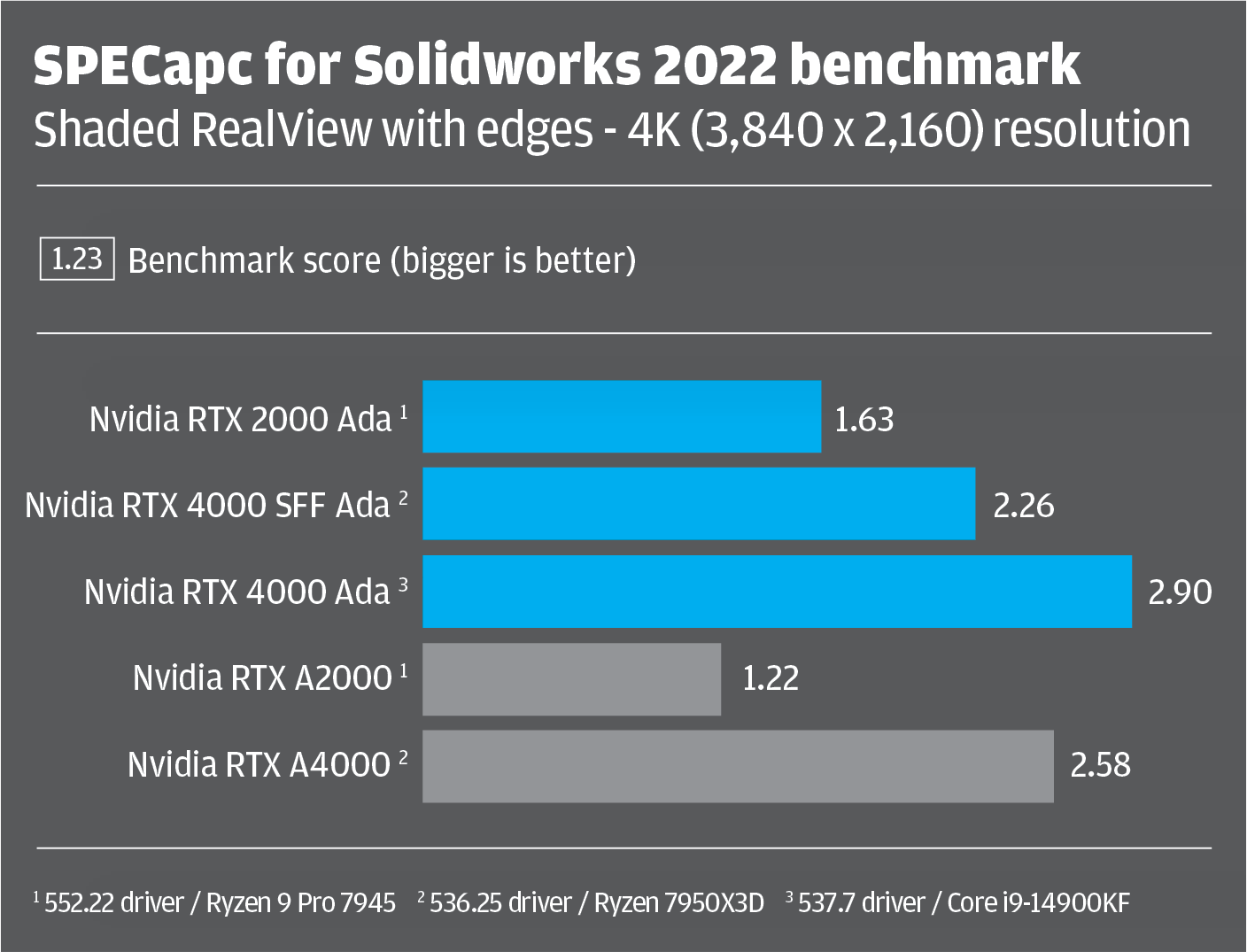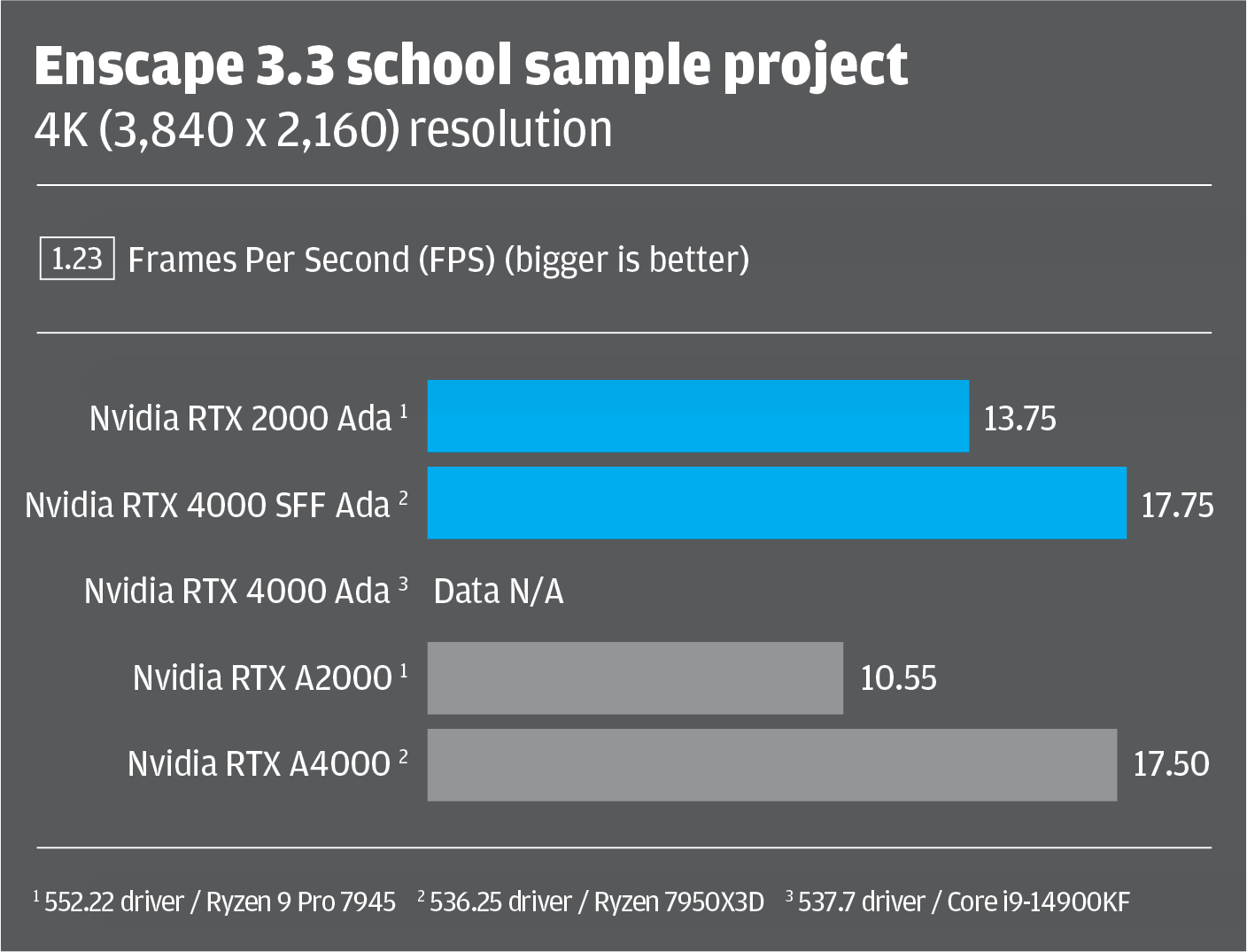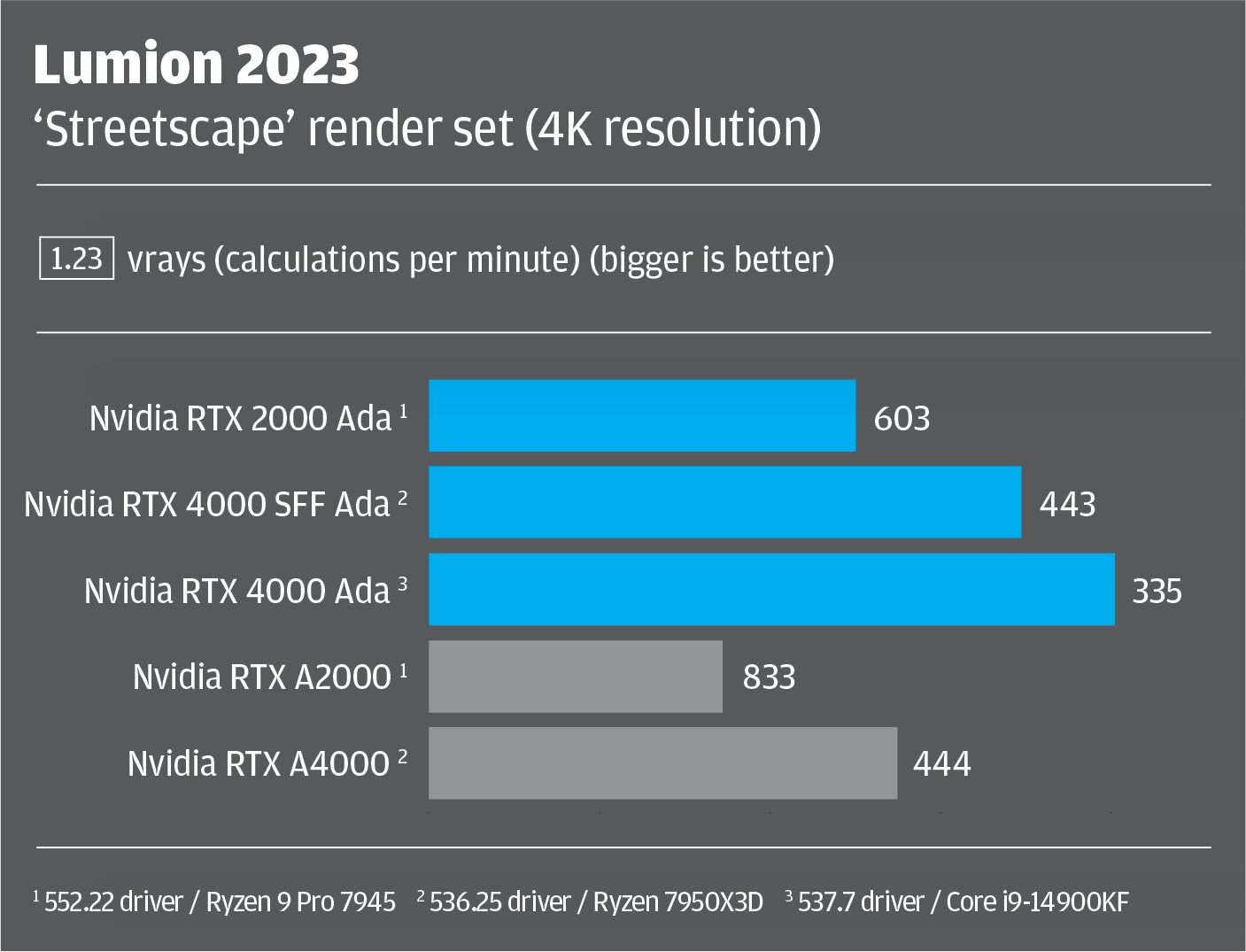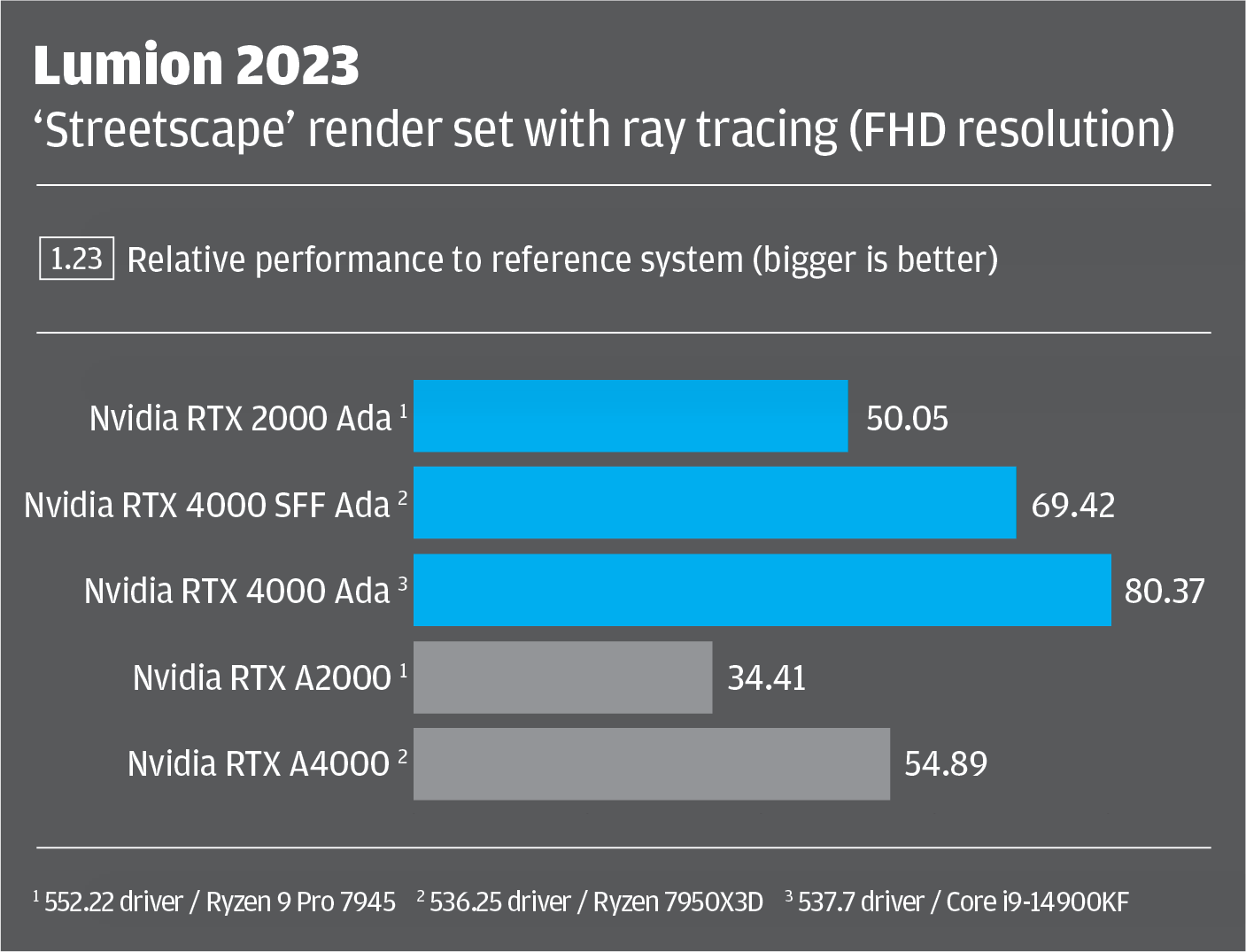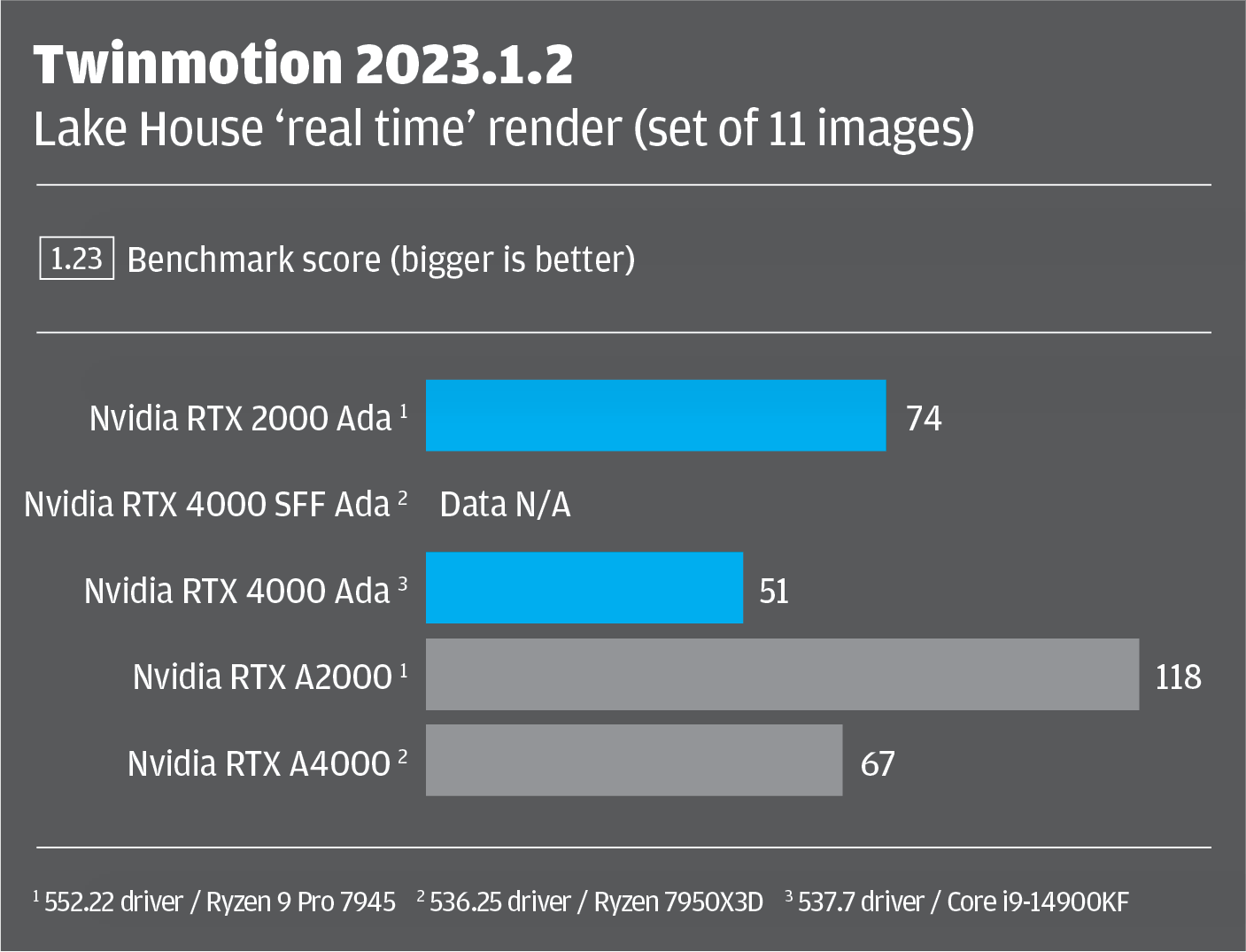This entry-level pro viz GPU is a great option for small workstations. Thanks to the Ada Generation architecture it gets a boost in all the right areas, including ray tracing and AI, but also receives an important memory uplift, writes Greg Corke
Small form factor (SFF) and Ultra Compact workstations are big business these days. They are among the biggest sellers at Dell, HP and Lenovo. And as you will see in this review of the Scan GWP-CAD A124R Micro, specialist system builders are also getting in on the action.
Small workstations need small GPUs. They require a special low-profile form factor, a compact GPU design with a shrunk down circuit board and a half height bracket for space efficiency.
Half of Nvidia’s recent pro graphics introductions are low-profile boards. There are four models: two take up a single slot on the motherboard, the Nvidia RTX A400 (4 GB) and the Nvidia RTX A1000 (8 GB), and two take up two slots, the Nvidia RTX 2000 Ada (16 GB) (the focus of this review) and the Nvidia RTX 4000 SFF Ada (20 GB) (review).
While the single slot cards are mostly targeted at CAD and BIM workflows, the dual slot cards are much more powerful. They are ideal for architects that want to push their workflows beyond the likes of Revit, Archicad and Allplan, into the realms of Enscape, Twinmotion, and D5 Render for real-time viz.
Read our other recent Nvidia RTX workstation GPU reviews
Nvidia RTX A1000
Nvidia RTX 4000 Ada Generation
Nvidia RTX 4000 SFF Ada Generation
Nvidia RTX 6000 Ada Generation
The Nvidia RTX 2000 Ada launched in February 2024 as part of a staggered roll out of Ada Generation GPUs. However, the card is only now starting to become available in the channel through PNY. Expect to see it in OEM workstations soon.
The Nvidia RTX 2000 Ada is not to be confused with the Nvidia RTX A2000, which has a remarkably similar name. The Nvidia RTX 2000 Ada actually replaces the Nvidia RTX A2000, which is built on the previous generation Nvidia Ampere architecture.
Like all Nvidia Ada Generation GPUs, the Nvidia RTX 2000 Ada comprises three different types of cores: Nvidia Ada Lovelace CUDA Cores for rasterisation and general-purpose processing, fourth-generation Tensor Cores for AI compute and third-generation RT Cores for ray tracing.
On paper, the Nvidia RTX 2000 Ada represents a big step up from the Nvidia RTX A2000. It boasts 12.0 TFLOPs vs 8.0 for single precision performance, 27.7 TFLOPs vs 15.6 for RT Core performance and 191.9 TFLOPs vs 63.9 for Tensor performance.
Tensor performance is important for generative AI, the importance of which is likely to grow in the coming years. Text-to-image tools like Stable Diffusion, for example, are gaining interest for ideation and concept design. According to Nvidia, the Nvidia RTX 2000 Ada will deliver 1.6 times better performance in Stable Diffusion compared to the Nvidia RTX A2000.
The Nvidia RTX 2000 Ada also adds more memory to the board. It has 16 GB of GDDR6 compared to 12 GB or 6 GB, in the Nvidia RTX A2000. 16 GB is significant as it should provide a good platform for most BIM-centric viz workflows.

Nvidia RTX 2000 Ada vs RTX 4000 SFF Ada
With the Nvidia RTX 2000 Ada (16 GB) and Nvidia RTX 4000 SFF Ada (20 GB) it’s the first time that Nvidia has had two viz capable low-profile GPUs from the same GPU architecture.
To the untrained eye, both GPUs look identical. Both are rated at 70W, so draw all their power from the motherboard’s PCIe slot. Both have four mini DisplayPort connectors, and both can be fitted with a half-height or full-height ATX bracket, so can be used in SFF workstations or full sized towers.
Naturally, the Nvidia RTX 4000 SFF Ada has a more powerful GPU (19.2 TFLOPs single-precision performance, 44.3 TFLOPs RT Core performance and 306.8 TFLOPs Tensor performance) and slightly more memory (20 GB). It also has more features, including support for Nvidia Quadro Sync II for display walls and 3D stereo for immersive 3D. As a result, it costs more than twice as much as the Nvidia RTX 2000 Ada — £1,160 + VAT versus £556.
It’s important to point out here that the Nvidia RTX 4000 SFF Ada has a full-height sibling, the Nvidia RTX 4000 Ada (review), that can only fit in full sized tower workstations. Both GPUs have the same core specs, but the Nvidia RTX 4000 Ada can draw twice as much power (130W), so you get significantly more performance out of the same silicon. They also cost exactly the same, so there’s little point in putting an Nvidia RTX 4000 SFF Ada in a tower workstation unless you’re extremely focused on energy efficiency.
Find many more articles like this in AEC Magazine
👉 Subscribe FREE here 👈
Nvidia RTX 2000 Ada on test
For testing, we compared the Nvidia RTX 2000 Ada (16 GB) with two other cards in the Ada Generation family: the low profile, dual slot Nvidia RTX 4000 SFF Ada (20 GB), and the full height, single slot Nvidia RTX 4000 Ada (20 GB).
We also included two previous generation Ampere GPUs: the low-profile, dual slot Nvidia RTX A2000 (12 GB), and the full height, single slot Nvidia RTX A4000 (16 GB).
Here, it’s important to state that our benchmark comparisons are not perfect, as not all GPUs were tested in the same machine. For the Nvidia RTX 2000 Ada and Nvidia RTX A2000 we used the latest 552.22 driver inside an AMD Ryzen 9 Pro 7945-based Scan GWP-CAD A124R Micro workstation.
For the other two GPUs, benchmark data was taken from previous lab tests. The Nvidia RTX 4000 SFF Ada and Nvidia RTX A4000 with 536.25 driver were tested inside an AMD Ryzen 9 7950X3D-based workstation from Armari. The Nvidia RTX 4000 Ada with 537.7 driver was tested in an Intel Core i9-14900KF-based workstation from Workstation Specialists.
We would expect the Nvidia RTX 4000 Ada benchmark scores to be elevated a little in 3D CAD, as the Intel Core i9-14900KF is faster in single threaded and lightly threaded workflows and CAD is typically CPU limited for 3D graphics. However, in graphics intensive real-time viz tools, the partner CPU shouldn’t make as much difference and, in GPU rendering, very little at all.
For CAD, the Solidworks benchmark scores only really tell part of the story. The reality is, we found the Nvidia RTX 2000 Ada able to easily handle the largest of assemblies, including the colossal 8,000+ component MaunaKea Spectroscopic Explorer telescope model.
The visualisation benchmarks gave greater insights into the capabilities of the Nvidia RTX 2000 Ada. For real time 3D we saw a performance bump of around 30 percent over the Nvidia RTX A2000.
However, our Unreal Engine and Enscape tests indicate the card is probably better suited to working at FHD resolution. When working at 4K, frame rates dropped below that golden 20 frames per second (FPS) threshold. However, this is of course dependent on the types of models you work with.
With less complex datasets, especially with real-time ray tracing disabled in Unreal Engine, performance at 4K may be perfectly acceptable. Either way, moving up the range to the Nvidia RTX 4000 SFF Ada will give you a significant boost, but only choose this GPU if your heart is set on a compact workstation. For the same price, you can have the Nvidia RTX 4000 Ada in a tower– although you can also fit this full height GPU in the slimlime HP Z2 SFF G9 workstation thanks to a riser card that rotates the GPU through 90 degrees.
In Twinmotion and Lumion, the Nvidia RTX 2000 Ada delivered batch renders between 27% and 37% faster than the Nvidia RTX A2000. This went up to 45% in KeyShot and 51% in Vray, both of which lean much more heavily on ray tracing, so take full advantage of the Nvidia RTX 2000 Ada’s far superior RT Core performance. With the Nvidia RTX 4000 SFF Ada, you’ll get an additional 26% out of Lumion, 33% out of Vray and 39% out of KeyShot.

The verdict
The Nvidia RTX 2000 Ada is another great pro graphics card from Nvidia that hits the price / performance sweet spot for BIM-centric architectural visualisation. For most practices it’s hard to justify giving every architect that has a viz requirement a workstation with a high-end GPU. But at £556 + VAT, the Nvidia RTX 2000 Ada is certainly affordable, and provides a great starting point for tools like Enscape, Twinmotion, Lumion and D5 Render. We’re not just talking frame rates and render times here though. The GPU also has enough memory to load up some fairly sizeable datasets.
Energy consumption also deserves a mention. With a peak power of 70W, the Nvidia RTX 2000 Ada uses significantly less electricity than its full height siblings and produces less heat. With many practices under pressure to hit sustainability targets, this is more important than ever.
The Nvidia RTX 2000 Ada might be primarily designed for small form factor / compact workstations, but it’ll be just as at home in a standard tower. Unlike the Nvidia RTX 4000 SFF Ada, there’s no full height equivalent.
We expect the Nvidia RTX 2000 Ada will start to be available in OEM workstations like the HP Z2 Mini G9, HP Z2 SFF G9, Lenovo ThinkStation P3 Ultra, and Dell Precision 3280 in the coming months. For now, you can get it through the channel via PNY, and in custom workstations like the extremely price competitive Scan GWP-CAD A124R Micro.




